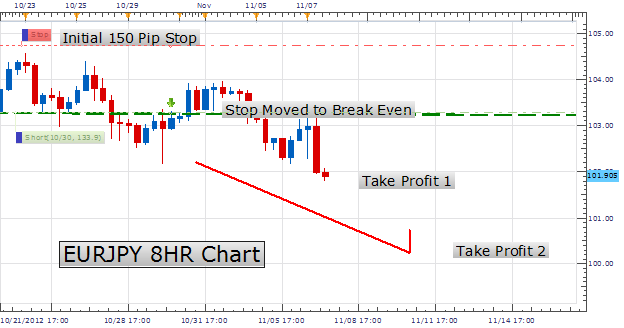One of the recurring issues I see with new traders is their difficulty with exiting open positions. This isn’t surprising, as so much emphasis is put on planning the perfect entry that traders tend to forget to develop a strategy for exiting a trade once it’s open. This is unfortunate as knowing when to exit a trade is vital for any trading plan, and is often what separates new traders from professionals in the Forex trading world. With this in mind, today we will examine how to effectively manage an open position using a trailing stop.
First, it is important to know that a fixed trailing stop is an advanced entry order designed to move a stop forward a specificed amount of pips after a position has moved in your favor. Traditionaly fixed trailing stops are used in conjuncture with a trending market strategy, to lock in profits on an extended move. Today we will take a look at a sample trade on the EURJPY 8HR chart pictured below, to examine how a trailing stop may work in our favor. The chart below depicts our initial entry to sell the EURJPY at 103.27. To initially contain our risk there is a stop of 150 pips being placed at 104.77, with the fixed trail set to 150.

The Chart above also depicts what will occur if the EURJPY moves in our favor as planned. Since our trail is set to 150 this means that if our trade moves 150 pips in our favor our stop will update that same amount. In this example this means our first trail would update our stop to 103.27, effectively moving out position to break even. From here the trailing stop will continue to lock in profit every time the trade moves in our favor the selected amount.
It is important to remember that the trailing stop by design is designated to close our trade. At any point in time a trade may move against our position and close the position at the designated stopping point. If this occurs immediately in the example above our position would be closed for a 150 pip loss. However, when using the benefits of a trailing stop we can then continue to lock in profit as the trend moves in our favor.




Frequently Asked Questions (FAQs)
Should traders always use a stop-loss?
Yes. Always using a stop-loss is a good habit for traders to get into. Stop-losses are an important part of any trading strategy and an essential component in risk-management. Furthemore, using a stop-loss and take-profit to ensure a positive risk-reward ratio on a trade has been shown to possibly increase a traders success.




